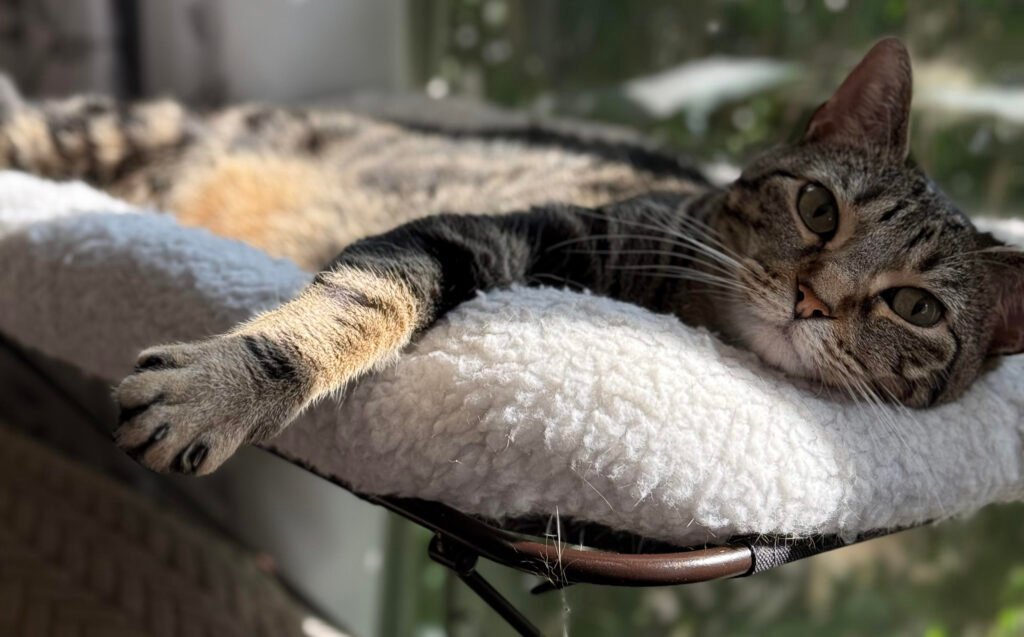
If you love to take your cat on outdoor adventures, you might be wondering what kind of protection they may need. After all, the outdoors does come with some safety risks for our fur babies.
One of those safety risks is exposure to the sun’s harmful ultraviolet (UV) rays. This is especially true if you are taking your kitty somewhere where they will be exposed to the sun for an extended period of time, such as the beach.
In this article, I will be addressing the question: Can cats get sunburn? I’ll also give you some tips for protecting your cat from the sun so they can continue to enjoy the beautiful outdoors safely while bonding with their favorite human (and can opener!).
Note: I am not a medical professional, and this article is not to be taken as medical or veterinary advice. Always contact a veterinarian regarding concerns about your pet’s health or behavior. Additionally, Caitycat is a participant in the Amazon Services LLC Associates Program, an affiliate advertising program designed to provide a means for sites to earn advertising fees by advertising and linking to amazon.com. As an Amazon Associate, I earn from qualifying purchases. This post may contain affiliate links, which means I may receive a commission, at no extra cost to you, if you make a purchase through a link. Please see my full disclosure for further information.
Can Cats Get Sunburn?
Just like humans are susceptible to the sun’s strong UV rays, so are cats, and this means they can get sunburn like us too.
But why? Aren’t cats covered in fur, so they are naturally protected from the sun?
Not necessarily. While fur does provide a layer of protection, it is not full proof. In addition, not all parts of a cat are covered in fur. For instance, the nose, ears, and around the eyes are most vulnerable to the sun’s harmful effects as there isn’t a lot of hair on these areas.
As you can probably imagine, hairless cats are the most at risk for damage from the sun, as are those that have very thin hair. However, the same precautionary measures should be taken for all cats, regardless of the amount of fur they have, to mitigate the risk of sunburn and the resulting health implications.
Health Complications From Sunburn in Cats
If a cat does get sunburn or is continuously exposed to the sun over a long period of time, some negative health complications can surface.
For example, according to VCA Animal Hospitals, solar dermatitis can arise, which is a disease caused by exposure to the sun. In the beginning stages of this disease, you may notice areas of hair loss with pink and scaly skin. As solar dermatitis in the cat progresses, the skin may begin to look more ulcerated and crusted.
In some cases, solar dermatitis may progress to the point of a malignant tumor developing, which is called a squamous cell carcinoma. According to PennVet Ryan Hospital, surgery is often the treatment for these types of tumors, and prognosis depends on many factors, such as tumor location, behavior/aggressiveness of the tumor, etc.

How to Protect Your Cat From the Sun
Now that you know how crucial it is to keep your fur baby from getting sunburn while outdoors, I’m going to give you some safety tips you can implement to ensure your cat stays safe while having fun in the sun.
Use a Cat-Safe Sunscreen on Your Kitty
Wait…cats can wear sunscreen?
You bet!
There are a variety of cat-safe sunscreens on the market, and you should be using it on your cat on the areas where they are most vulnerable to the sun (nose, ears, etc.).
I recommend the Sit Stay Forever brand of cat-safe sunscreen from Amazon, as it is waterproof, lick-safe, provides full-body UV coverage, and the brand aims for sustainability in all of their products. You can buy it here: https://amzn.to/46uDTdX.
Limit the Time Your Cat Is in the Sun
This seems like a no-brainer, but sometimes it’s easy to let time slip by while you’re having a good time. Two hours can easily turn into eight if you’re enjoying bonding with your kitty outside, especially if you take your cat to the beach.
You should keep an eye on the clock when you bring your cat outside, and maybe even consider setting a timer or an alarm for how long you plan to be outdoors with your cat.
Watch for Early Signs of Sunburn in Your Cat
Early intervention is key, so keep an eye on your cat to make sure they aren’t showing any early signs of having a sunburn.
According to Dr. Amanda Chambers, DVM, key indicators that your cat may have been burnt by the sun are scratching, inflammation, warmer skin than usual, patches of hair loss, or extra sensitivity when you try to touch a certain area.
Keep an eye out for these signs and contact your vet right away if you notice any!
Take Your Cat to the Vet Regularly
As part of your routine visits to the vet, you can ask your vet to inspect your cat’s skin to look for any signs of sunburn or solar dermatitis. This is a way to be proactive and ensure that any signs of sun damage are assessed and remedied as soon as possible!
Can Indoor Cats Get Sunburn?
You might be surprised to learn that indoor cats can actually get sunburn too, even if they never step outside. A lot of indoor cats, like my girl Luna, enjoy sunbathing in windows, in front of doors, and really anywhere sun is coming in. You may not think your kitty is at risk of sunburn from sun coming in through glass, but they are!
The Skin Cancer Foundation warns that while the primary sunburn ray (UVB) is mostly blocked by glass, more than 50% of UVA rays (the main cause of premature skin aging) can penetrate glass.
This leaves your cat at risk of sun damage even if they are primarily indoors and only are exposed to sun through windows or glass.

In Conclusion
Protecting your fur baby from the sun is so important, especially if you regularly bring them outdoors with you. Using a cat-safe sunscreen, limiting your cat’s time in the sun, watching for early signs of sunburn, and regular vet checkups are all ways you can ensure your kitty stays happy and healthy so they can continue to go on adventures with you!

